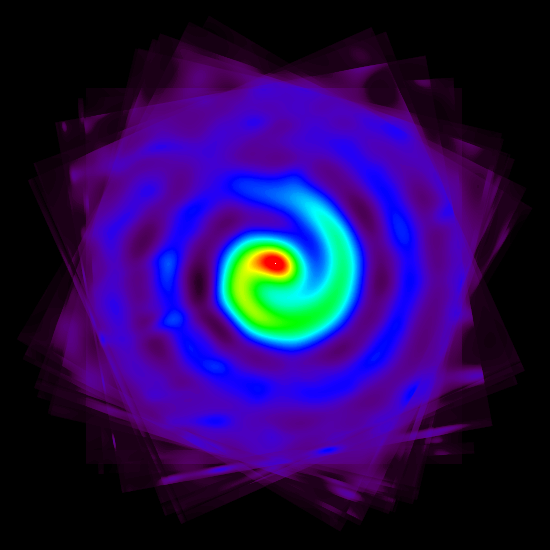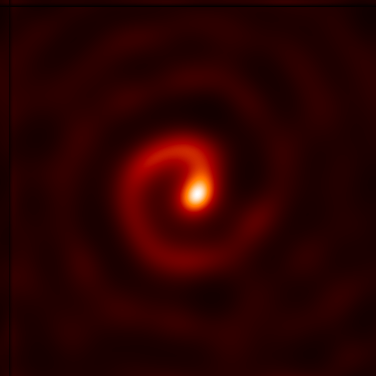
WR 104: The prototype Pinwheel Nebula

WR 104: The prototype Pinwheel Nebula

The most extensive and detailed imaging study to date of the beautiful and exotic colliding-wind binary Pinwheel system Wolf-Rayet 104 has caught the motion of this stellar performer in a series of time-lapse movie frames taken over an interval of more than six years.
A sequence of 11 sharp frames show the elegant spiral nebula in the constellation of Sagittarius to be rotating in a circle every 8 months, keeping precise time like a jewel in a cosmic clock. In the image to the left, we have rotated the camera frame of each of the 11 images so as to follow the motion, and as a result we can stack all our images into a single false-colour composite.
So why does WR 104 appear as a spiral? Powering the heart of the system are a pair of luminous hot stars locked in a binary orbit. As they circle one another, winds driven from the two stellar surfaces collide in the intervening space. Plumes of streaming gas blown off by the stars eventually become entangled and twisted by the orbital motion of the binary star. Glowing hot dust forming along the length of the gas tail acts as a vivid tracer of all this turbulence and activity, painting a spiral banner on the sky in excess of 200 AU long (thirty billion kilometers, or about one light-day).
The new data, reported in the March 1st, 2008 issue of the prestigious Astrophysical Journal, were obtained with specialized techniques in near-infrared light (2.2 microns) at the Keck telescope , the world's largest optical observatory. In another way to visualize the data, frames covering the rotation of the spiral plume over its 8-month orbit have been stitched together into a time-lapse movie (red colour scale image to the right).
Exceeding previous studies both for clarity of detail and for coverage of the temporal changes, the new data allow a fascinating exploration of the prehistory and possible future evolution of the Wolf-Rayet binary system. The high degree of circularity of the orbit of the massive stars at the heart of WR 104 speaks of a violent and turbulent past, in which the O-star companion stripped away the outer layers of gas from the Wolf-Rayet.
But the fireworks which lie ahead for WR 104 should dwarf any performances from the past. As the last known stable stellar phase before a supernova explosion, Wolf-Rayet stars are regarded by Astronomers as ticking bombs. For a star such as WR 104, the fuse is now very short (to an astronomer) and it may explode any time within the next few hundred thousand years. Although an eventual supernova explosion in a system with the proximity of WR 104 would no doubt put on a very impressive show for future earthbound stargazers, such explosions occurring at the vast interstellar distances are normally thought to be harmless.
However, the enigmatic WR 104 system has one final card to play, which gives Astronomers just a little pause for thought. The new data show that the orientation of the spin-axis of the system, with respect to our vantage point from Earth, is almost exactly aligned. As nearly as we can tell, we are looking directly down upon the polar direction of the spinning binary stars.
Is the spiral nebula WR 104 a view down the gunbarrel? |
|---|
The problem with explosions in rapidly spinning stars is that they are likely to be quite different from the simple spherical blast-wave of their slowly-rotating kin. It is widely believed among astronomers that such supernova explosions exhibit a preferred axis aligned with the spin of the progenitor star. Just how strong the degree of asymmetry in the explosion, with energy and matter beamed along the axis, is something astronomers are still trying to decide.
The worst-case scenario, however, is something witnessed by networks of sensitive space telescopes nearly every day. The powerful Gamma-Ray Bursts (GRBs), first discovered in the 1960's by cold war satellites eavesdropping on nuclear tests, are believed to be among the most powerful and asymmetric explosions in the cosmos. The tightly-beamed energy of these stellar explosions, occupying a cone of only 12 degrees opening angle, could well leave a narrow trail of destruction across a considerable swath of the galaxy (several kiloparsecs).
Could WR 104 be the Death Star? |
|---|
So our accidental priveliged pole-on view onto this system may result in something beyond a pretty spiral apparition in the sky. We are looking along the axis of one of one of the nearest imminent Wolf-Rayet supernova progenitors known. If there is a significant beaming of energy along this axis, could the Earth be in harm's way?
There is still much work to do before the idea that WR 104 could pose a threat to Earth's biosphere should be given too much credence. For starters, the degree to which the system is pointing exactly in our direction needs to be firmed up with spectroscopic observations. Data so far are just not accurate enough to nail down the orientation precisely.
But perhaps the biggest uncertainty of all is the exact nature of WR 104's future supernova explosion. The detailed makeup of gamma-ray bursts and asymmetric supernova explosions is a very hot area of current research: ideas are changing and evolving all the time. Our best present guess is that a full-fledged Gamma-Ray Burst from WR 104 is unlikely, although just how much energy might be beamed our way when it does go supernova is uncertain.
More research to firm up the orientation, and to predict the degree of directed energy beaming in the coming supernova explosion, may help give us just a little more peace of mind as we gaze upwards into the spiral coils of this uniquely beautiful system.

Want a second opinion about our impending doom? There is a nicely reasoned and insightful discussion of the risk posed by this system at Phil Plait's great Bad Astronomy website.
What have the press made of this story? Click here for an archive of some stories taken from the web.
Further web pages devoted to these fascinating spiral systems can be found for WR 104 (original discovery page); WR 98a the second Pinwheel; and also the beautiful Quintuplet Cluster.
Principal Researchers:
Peter Tuthill
is a researcher in the
School of Physics at the University of Sydney, Australia.
John Monnier works at the University of Michigan
These links are for download of images and press release materials:
movie illustrating formation of the spiral (mpeg4 format).
another movie illustrating formation of the spiral (mpeg4 format).
Red Color Image file of 11 stacked frames (gif format).
Large Rainbow-Color Image file (2000px gif format).
Large Rainbow-Color Image file (2000px jpeg format).
Large high-quality red-scale "filmstrip" image.
Movie of the 8-month time-lapse rotation.
Red Color Image file of 11 stacked frames (LARGE gif format).
Red Spiral model (LARGE gif format).
BW Spiral model (LARGE gif format).
BW model (LARGE gif format).
Coords: RA/Dec = 18:02:04.07 -23:37:41.2 (J2000) V=14mag
This research appears in:
For an
Abstract and full preprint of the paper, click here (link to Astro-PH)
For
FULL TEXT of the paper, click here (link to Astrophysical Journal)
This research was supported by grants from the
Australian Research Council
and the
US National Science Foundation
Stellar Astronomy and Astrophysics Program.
For more information, contact: Dr Peter Tuthill
 physics.usyd.edu.au)
physics.usyd.edu.au)